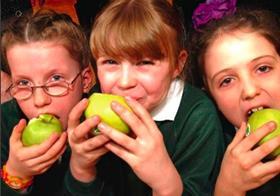
Despite campaigns by household-name chefs, a survey of primary schoolchildren’s packed lunches in 2016 has revealed that they are still of poor quality and rarely meet all the food-based standards set for school meals.
Vegetables and salad in particular are largely absent from packed lunches, while snack foods such as crisps and confectionery are common. Lunchboxes contain higher amounts of saturated fat, added sugars and salt and lower amounts of vitamins and minerals than recommended. These results are similar to the original survey carried out in 2006.
School meals, on the other hand, have been transformed in the past decade. In 2006, standards were introduced which stipulated that school meals should provide a portion of each of the following five foods – protein-rich food such as unprocessed meat or fish, low-fat carbohydrate food such as bread or potato (not fried), dairy food such as yogurt or cheese, fruit and vegetables. The standards also restricted three food types including sweetened drinks, savoury snacks and confectionery (this includes chocolate-covered biscuits and cereal bars). The School Food Plan, which came in subsequently in 2014, upheld these food-based standards.
It is therefore likely that the gap between the quality of school meals and packed lunches has widened. In 2006, we found that only 1.1 per cent of the packed lunches met all the standards, including the five healthy foods and the three restricted food types. In 2016, our survey showed this had increased slightly to 1.6 per cent. Despite numerous awareness campaigns on childhood obesity and excessive sugar consumption, children are still being provided with packed lunches with high levels of snack foods and too little fruit and particularly vegetables.
Less than a fifth (17 per cent) of lunchboxes contain any vegetables or salad and the majority contain too many sweet and savoury snacks (52 per cent and 60 per cent respectively) and sweetened drinks (46 per cent).
Matter of taste
While overall these results are depressingly similar to 10 years ago, there have been, reassuringly, some moderate but important improvements, indicating that better quality lunches are possible. The percentage of children provided with a sweetened drink has decreased from 61 per cent in 2006 to 46 per cent in 2016. This indicates that good consistent advice and help from schools and the food industry enable parents to make better choices for their child’s packed lunch; but we are still a long way from where we want to be.
Tough choices
Providing healthy foods requires commitment and perseverance and is more time consuming as it involves buying a range of fresh foods, chopping up fruits and vegetables and getting children to try new foods that they may not prefer initially. There will be resistance to changes by the child if their friends are eating more snack foods and less salad. Although there are various sources of ideas for parents keen to prepare the perfect lunch for their child, clearly it is not enough to bring about real change.
Action is also needed from schools and the food industry. Some schools currently have no policies, while others have ones that are too draconian for parents to stomach.
Change of menu
I suggest that the first step should be for primary schools to ban all sweetened drinks and just serve water at lunchtime. This will considerably reduce sugar intake at lunch – and many schools have already taken this step. A second step would be to reduce – but not ban – foods high in saturated fats and limit each child to one snack food (crisps, chocolate biscuit or pastry) a day.
The best packed lunches recorded in this study included all the foods recommended in the School Food Plan and none of the restricted foods. For example, a chicken and salad sandwich, grapes, a yoghurt and water. Although the ultimate goal is to exclude all savoury and sweet snacks, we are so far from this goal that to completely ban snack foods is too much for many parents and children to support.
The food industry is also an important player when it comes to supporting families making healthier choices. Smaller portions of snack foods, such as crisps, would be helpful for younger children to prevent them filling up on these and not eating their sandwich and fruit. There also needs to be an increase in the availability of healthy snacks that can be used in children’s lunches that are higher in fibre and lower in added sugars.
In order to improve the quality of food brought into schools it is clear we need to involve parents, schools and the food industry. We also hope that the All Party Parliamentary Group for School Food will provide clear guidance for schools and parents. Maintaining a commitment from all these key stakeholders will result in the culture change needed for successful improvements in dietary behaviour. I believe this is possible and hope we see real progress in the next 10 years – and truly benefit children’s future health.



